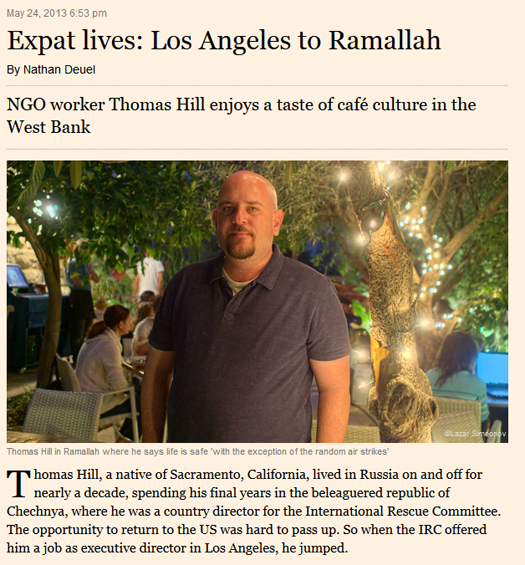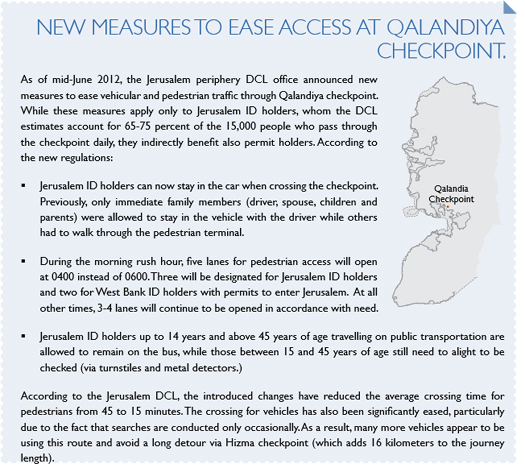Does Thomas Hill, an employee of Save the Children in the West Bank, believe that he is somehow helping Palestinian children by making up stories about Israeli air strikes in Ramallah?
In a May 24 “life and arts” feature in the Financial Times, Nathan Deuel describes Hill’s life in Ramallah, and the job which finds him “travelling weekely to Gaza, Hebron, Nablus and Jerusalem” (“Expat lives: Los Angeles to Ramallah“). “Hill’s ability to move around so widely is rare and gives him a good perspective on the region,” enthuses Deuel about the California native who relocated to the Middle East in May 2012.
The notion that Hill possesses a “good perspective on the region” is completely demolished as the Californian muses about his Ramallah life: “Things here are inconvenient, but it’s safe — with the exception of the random air strike.”
You don’t need to live in Ramallah, or travel weekly to Gaza, Hebron, Nablus and Jerusalem, to know that there have been no air strikes in Ramallah — random or otherwise — in something like 10 years. And with all due respect to Hill, his “good perspective” does not stretch back that far. According to the article, he and his wife arrived in Israel in May 2012, moved on to Ramallah sometime later. A photo caption at the top of the article (see screen capture below) repeats the false claim that there are air strikes in Ramallah.

Jerusalem Curfews, Checkpoints
The aid worker with the “good perspective” also gives a false depiction of eastern Jerusalem, where he considered living last spring. Deuel reports: “But as beautiful and romantic as East Jerusalem’s ancient streets and sights are, Hill says the checkpoints, curfews and movement restrictions make it an awkward place to live.”
There were curfews in eastern Jerusalem last spring? The last record of any curfew in Jerusalem that we can locate dates back to 1988, nearly a quarter of a century before Hill and his wife “explored East Jerusalem.” Before, that, when Jordan controlled eastern Jerusalem, King Hussein imposed curfews in the 1960s, as the New York Times reported April 22, 2013 from its archives from 50 years earlier (“1963 King Ends Parliament in Jordan“). But Hill’s reference to present day curfews in eastern Jerusalem is completely unfounded.
What about his claim that there are checkpoints in Jerusalem? If he plans on living in the Shoafat refugee camp, he would indeed have to cross through a checkpoint in and out of his neighborhood. But for the rest of the neighborhoods, there are no checkpoints. The several checkpoints in the Jerusalem area lie on the municipal boundary separating Jerusalem from the West Bank, and are not in Jerusalem itself, as demonstrated in the B’Tselem materials related to checkpoints and East Jerusalem. B’Tselem makes no mention of East Jerusalem in its page on checkpoints and conversely makes no mention of checkpoints in its page on East Jerusalem. There is one reference to a checkpoint “separating the villages of Bidu and Beit Iksa” in its most recent Excel spreadsheet listing the checkpoints, updated in February 2013 but that’s it. What is Hill talking about? His testimony about checkpoints in East Jerusalem is about as reliable about his statement regarding air strikes in Ramallah.
Kalandia Improves, Times Misleads
About the Kalandia from northern Jerusalem to the West Bank, Deuel reports:
. . . Hill [and his wife] Parker passed through the security checkpoint, Kalandia, gateway to the Palestinian town of Ramallah, in central West Bank, and just five miles north of Jerusalem. On a bad day, the process can take two hours — an experience endured by thousands of Palestinians and foreigners every day. (Emphasis added.)
In this self-contradiction, Deuel claims that on bad days the process can take two hours, but at the very same time he says that “thousands” endure that experience “every day.” So what actually happens for those passing through Kalandia on an average day? According to a September 2012 report issued by the United Nations Office for the Coordination of Humanitarian Affairs (OCHA), a series of “new measures to ease vehicular and pedestrian traffic through Qalandiya checkpoint” since June 2012 have shortened the time pedestrians and vehicles have to wait to cross. As a result, reported OCHA, the average wait for pedestrians is down to 15 minutes from 45 minutes, and the wait for vehicles is also significantly reduced.

The Financial Times has allowed a story about an expatriot living in the West Bank to become yet another bit of poorly researched propaganda that portrays Israel in an unfair and inaccurate light.
